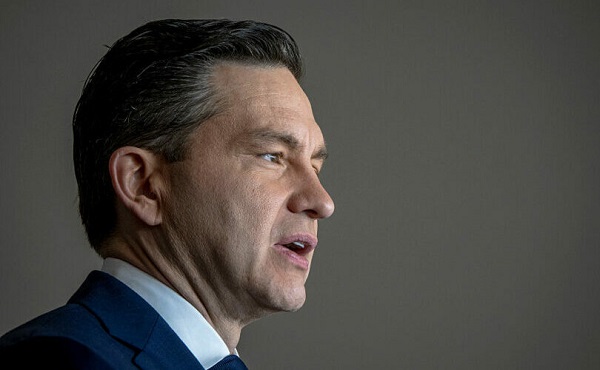Business
Government laws designed to rescue Canadian media have done the opposite

From the MacDonald-Laurier Institute
This article first appeared as the cover story to our September 2023 issue of Inside Policy. You can download the full issue here.
By Peter Menzies, October 4, 2023
The federal government has made a regulatory mess with wrongheaded legislation targeting digital media content.
Few things are more fundamental to a nation’s economic prosperity and social cohesion than a robust communications framework.
Canada has its challenges in terms of rural and northern internet and mobile connectivity, but the nation’s overall communications mainframe is, by most international measures, in good shape. The rest of the story involving what gets carried on the mainframe (i.e., the actual content) isn’t as pretty. In fact, two recent communications policy initiatives proposed by the federal government have put tens of thousands of jobs at risk in the creative and news industries.
Money goes where it is likely to generate profit, and if some key arteries aren’t unclogged quickly, the flow of communications investment dollars in Canada could seize up. Worse, the future of what has been a thriving creative economy, driven by independent content creators, is now uncertain.
Meanwhile, the news industry is on the cusp of becoming permanently reliant on government subsidies – a dependency that’s certain to undermine the public’s already wavering trust in its independence.
But first, the good news. While measures vary by source and date, Canada consistently ranks among the world’s top 20 nations when it comes to fixed broadband connectivity, and as high as No. 1 in the world when it comes to mobile internet capacity. Given that most of nations in the top ten for broadband connectivity are smaller in landmass than Prince Edward Island, this is a considerable achievement for a country the size of Canada. This connectivity, however, has come at a premium – consumer in this country are historically among those paying the highest rates anywhere in the world, particularly when it comes to mobile plans. Costs to consumers remain high but have been trending downward in recent years as carriers shift strategic priorities from acquiring new consumers to retaining existing ones.
Far more challenging is a regulatory environment that is less than friendly when it comes to attracting private investment. The Canadian Radio-television and Telecommunications Commission (CRTC) has been risk-averse in its dealings with Mobile Virtual Network Operators (MVNOs) and smaller Internet Service Providers (ISPs) looking for competitive access rates to incumbent networks. Still, competition is one area that appears to be a priority for the CRTC. The regulator’s new chair, Vicky Eatrides, has a background in competition policy; a new vice chair, Adam Scott, is thoroughly familiar with the Telecom industrial framework; and the new Ontario Regional Commissioner, Bram Abramson, has experience as a regulatory officer for a smaller telco. (Abramson’s former employer, TekSavvy Solutions, recently waved the white flag in its efforts to compete in the Canadian market and put itself up for sale.)
Now the bad news – and, fair warning, there’s a lot of it.
Canada is aggressively regulating the internet – not in priority areas such as privacy, algorithms and data collection, but in terms of its content and its users’ freedom of navigation. The Online Streaming Act (Bill C-11) came into force in the spring, amending the Broadcasting Act to define the internet’s audio and video content as “broadcasting” and, as such, placing all this content under the authority of the CRTC. The goals remain the same as they did during the broadcast radio and cable television world of the early 1990s: the funding of certified TV and film properties, ensuring Canadian content (CanCon) gets priority over foreign programming and ensuring designated groups – BIPOC and LGBTQ2S, among other acronyms – and official language minorities are represented. How exactly the CRTC intends to achieve this without disrupting what has been a booming decade for film and television production in a freewheeling global market remains to be seen. As does how it will give its supply-managed content priority without imposing economic harm on the 100,000 Canadians who earn a living in the unlicensed, uncertified world of YouTube and other major streaming platforms.
While the CRTC has promised to provide at least preliminary answers to these questions by the end of next year, years of regulatory haggling and court challenges await and the regulator’s reputation for the timely resolution of matters is spotty at best. As of September 22, for instance, it still hadn’t dealt with a cabinet order to review its CBC licensing decision; a decision which, itself, which took 18 months for the regulator to reach (following a January 2021 hearing that was held three years after the term of the CBC’s previous license had expired). Regulatory sloth of this nature on a routine matter does not inspire much optimism for the expedient handling of the far more complex issue of online streaming.
Indeed, the burden of the Online Streaming Act has already overwhelmed the CRTC’s administrative capacities. In August, it autorenewed the licenses of 343 television channels, discretionary services, and cable and satellite services for two to three years each. It subsequently announced it wouldn’t be dealing with any radio matters at all for “at least” two years. It even nervously punted a demand for the cancellation of Fox News’ Canadian carriage into the future by declaring it necessary to re-do the entire framework involving cable carriage of foreign television channels. It has clearly signaled that it plans to manage nothing other than telecom and Online Streaming Act issues for years to come. Everything else is on hold until such time comes to initiate a catch-up process that, in turn, will itself take years to clear the logjam. All this at a time of significant disruption that demands corporate and regulatory nimbleness.
But even what appears to be catastrophic regulatory arrest pales in comparison to the impact of the federal government’s second significant piece of new internet legislation: the Online News Act. Rarely has legislation designed to assist a sector – news production – been so poorly constructed that it has managed to make everything worse for everyone involved.
Based on the unproven premise that Big Tech companies were profiting from “stealing” content from news organizations, the Act was designed to force Meta (Facebook’s parent company) and Google to redistribute their considerable advertising revenue to those who used to receive the lion’s share of this revenue – newspapers and broadcasters. From the beginning, Meta indicated that the premise and the cost of the legislation, unless amended, would force it to cease the carriage of links to news stories and suspend its existing support programs for Canadian journalism.
The government and the news industry lobbyists who backed the bill grossly overestimated their economic value to Meta and insisted the tech giant was bluffing. Last week, however, Brian Myles, Director of Le Devoir, told an online panel hosted by the Canadian Journalism Foundation that it was clear Meta wasn’t bluffing and, going forward, news organizations would have to adapt to its exit from the market and the considerable financial impact it will have on their industry. He nevertheless held out hope that a rapprochement of some kind might still be possible with Google.
Like Meta, Google has indicated that it, too, will suspend both news linkage and its current partnerships with Canadian news organizations, unless the federal government can provide more economically acceptable options than what it has heretofore offered. As much financial harm as Meta’s departure will cause, there is consensus that Google’s departure – if it occurs – would be a disaster on a nuclear scale.
Even if a deal is reached, the best the news industry can hope for is that Google’s financial concessions will offset a portion of the losses suffered from losing access to Facebook, Instagram and Threads (among other Meta properties). Any money that can be squeezed out of an agreement with Google would be meaningful but a far cry from the hundreds of millions the industry was dreaming of a year ago. The largest recipients of any such windfall, of course, will be those who least need it – namely CBC and Bellmedia.
The bottom line is that, following passage the Online News Act, there will be less revenue for Canadian news organizations than there was just a few months ago. As a result, publishers are pleading for “temporary” measures such as the Journalism Labour Tax Credit and Local Journalism Initiative to be not just extended but enhanced. Up to 35 percent of legacy newsrooms costs would be covered by the federal government while, without Facebook, it will be near impossible for local news innovators outside of the legacy bubble to build audiences.
Next up is an anticipated Online Harms Act, designed to control “lawful but awful” speech through a government-appointed Digital Safety Commissioner. Expect more policy mayhem in the months to come.
Peter Menzies is a senior fellow at MLI and a former vice-chair of the CRTC.
2025 Federal Election
Carney’s budget is worse than Trudeau’s

Liberal Leader Mark Carney is planning to borrow more money than former prime minister Justin Trudeau.
That’s an odd plan for a former banker because the federal government is already spending more on debt interest payments than it spends on health-care transfers to the provinces.
Let’s take a deeper look at Carney’s plan.
Carney says that his government would “spend less, invest more.”
At first glance, that might sound better than the previous decade of massive deficits and increasing debt, but does that sound like a real change?
Because if you open a thesaurus, you’ll find that “spend” and “invest” are synonyms, they mean the same thing.
And Carney’s platform shows it. Carney plans to increase government spending by $130 billion. He plans to increase the federal debt by $225 billion over the next four years. That’s about $100 billion more than Trudeau was planning borrow over the same period, according to the most recent Fall Economic Statement.
Carney is planning to waste $5.6 billion more on debt interest charges than Trudeau. Interest charges already cost taxpayers more than $1 billion per week.
The platform claims that Carney will run a budget surplus in 2028, but that’s nonsense. Because once you include the $48 billion of spending in Carney’s “capital” budget, the tiny surplus disappears, and taxpayers are stuck with more debt.
And that’s despite planning to take even more money from Canadians in years ahead. Carney’s platform shows that his carbon tariff, another carbon tax on Canadians, will cost taxpayers $500 million.
The bottom line is that government spending, no matter what pile it is put into, is just government spending. And when the government spends too much, that means it must borrow more money, and taxpayers have to pay the interest payments on that irresponsible borrowing.
Canadians don’t even believe that Carney can follow through on his watered-down plan. A majority of Canadians are skeptical that Carney will balance the operational budget in three years, according to Leger polling.
All Carney’s plan means for Canadians is more borrowing and higher debt. And taxpayers can’t afford anymore debt.
When the Liberals were first elected the debt was $616 billion. It’s projected to reach almost $1.3 trillion by the end of the year, that means the debt has more than doubled in the last decade.
Every single Canadian’s individual share of the federal debt averages about $30,000.
Interest charges on the debt are costing taxpayers $53.7 billion this year. That’s more than the government takes in GST from Canadians. That means every time you go to the grocery store, fill up your car with gas, or buy almost anything else, all that federal sales tax you pay isn’t being used for anything but paying for the government’s poor financial decisions.
Creative accounting is not the solution to get the government’s fiscal house in order. It’s spending cuts. And Carney even says this.
“The federal government has been spending too much,” said Carney. He then went on to acknowledge the huge spending growth of the government over the last decade and the ballooning of the federal bureaucracy. A serious plan to balance the budget and pay down debt includes cutting spending and slashing bureaucracy.
But the Conservatives aren’t off the hook here either. Conservative Leader Pierre Poilievre has said that he will balance the budget “as soon as possible,” but hasn’t told taxpayers when that is.
More debt today means higher taxes tomorrow. That’s because every dollar borrowed by the federal government must be paid back plus interest. Any party that says it wants to make life more affordable also needs a plan to start paying back the debt.
Taxpayers need a government that will commit to balancing the budget for real and start paying back debt, not one that is continuing to pile on debt and waste billions on interest charges.
2025 Federal Election
As PM Poilievre would cancel summer holidays for MP’s so Ottawa can finally get back to work

From Conservative Party Communications
In the first 100 days, a new Conservative government will pass 3 laws:
1. Affordability For a Change Act—cutting spending, income tax, sales tax off homes
2. Safety For a Change Act to lock up criminals
3. Bring Home Jobs Act—that repeals C-69, sets up 6 month permit turnarounds for new projects
No summer holiday til they pass!
Conservative Leader Pierre Poilievre announced today that as Prime Minister he will cancel the summer holiday for Ottawa politicians and introduce three pieces of legislation to make life affordable, stop crime, and unleash our economy to bring back powerful paycheques. Because change can’t wait.
A new Conservative government will kickstart the plan to undo the damage of the Lost Liberal Decade and restore the promise of Canada with a comprehensive legislative agenda to reverse the worst Trudeau laws and cut the cost of living, crack down on crime, and unleash the Canadian economy with ‘100 Days of Change.’ Parliament will not rise until all three bills are law and Canadians get the change they voted for.
“After three Liberal terms, Canadians want change now,” said Poilievre. “My plan for ‘100 Days of Change’ will deliver that change. A new Conservative government will immediately get to work, and we will not stop until we have delivered lower costs, safer streets, and bigger paycheques.”
The ’100 Days of Change’ will include three pieces of legislation:
The Affordability–For a Change Act
Will lower food prices, build more homes, and bring back affordability for Canadians by:
- Cutting income taxes by 15%. The average worker will keep an extra $900 each year, while dual-income families will keep $1,800 more annually.
- Axing the federal sales tax on new homes up to $1.3 million. Combined with a plan to incentivize cities to lower development charges, this will save homebuyers $100,000 on new homes.
- Axing the federal sales tax on new Canadian cars to protect auto workers’ jobs and save Canadians money, and challenge provinces to do the same.
- Axing the carbon tax in full. Repeal the entire carbon tax law, including the federal industrial carbon tax backstop, to restore our industrial base and take back control of our economy from the Americans.
- Scrapping Liberal fuel regulations and electricity taxes to lower the cost of heating, gas, and fuel.
- Letting working seniors earn up to $34,000 tax-free.
- Axing the escalator tax on alcohol and reset the excise duty rates to those in effect before the escalator was passed.
- Scrapping the plastics ban and ending the planned food packaging tax on fresh produce that will drive up grocery costs by up to 30%.
We will also:
- Identify 15% of federal buildings and lands to sell for housing in Canadian cities.
The Safe Streets–For a Change Act
Will end the Liberal violent crime wave by:
- Repealing all the Liberal laws that caused the violent crime wave, including catch-and-release Bill C-75, which lets rampant criminals go free within hours of their arrest.
- Introducing a “three strikes, you’re out” rule. After three serious offences, offenders will face mandatory minimum 10-year prison sentences with no bail, parole, house arrest, or probation.
- Imposing life sentences for fentanyl trafficking, illegal gun trafficking, and human trafficking. For too long, radical Liberals have let crime spiral out of control—Canada will no longer be a haven for criminals.
- Stopping auto theft, extortion, fraud, and arson with new minimum penalties, no house arrest, and a new more serious offence for organized theft.
- Give police the power to end tent cities.
- Bringing in tougher penalties and a new law to crack down on Intimate Partner Violence.
- Restoring consecutive sentences for multiple murderers, so the worst mass murderers are never let back on our streets.
The Bring Home Jobs–For a Change Act
This Act will be rocket fuel for our economy. We will unleash Canada’s vast resource wealth, bring back investment, and create powerful paycheques for workers so we can stand on our own feet and stand up to Trump from a position of strength, by:
- Repealing the Liberal ‘No Development Law’, C-69 and Bill C-48, lifting the cap on Canadian energy to get major projects built, unlock our resources, and start selling Canadian energy to the world again.
- Bringing in the Canada First Reinvestment Tax Cut to reward Canadians who reinvest their earnings back into our country, unlocking billions for home building, manufacturing, and tools, training and technology to boost productivity for Canadian workers.
- Creating a One-Stop-Shop to safely and rapidly approve resource projects, with one simple application and one environmental review within one year.
Poilievre will also:
- Call President Trump to end the damaging and unjustified tariffs and accelerate negotiations to replace CUSMA with a new deal on trade and security. We need certainty—not chaos, but Conservatives will never compromise on our sovereignty and security.
- Get Phase 2 of LNG Canada built to double the project’s natural gas production.
- Accelerate at least nine other projects currently snarled in Liberal red tape to get workers working and Canada building again.
“After the Lost Liberal Decade of rising costs and crime and a falling economy under America’s thumb, we cannot afford a fourth Liberal term,” said Poilievre. “We need real change, and that is what Conservatives will bring in the first 100 days of a new government. A new Conservative government will get to work on Day 1 and we won’t stop until we have delivered the change we promised, the change Canadians deserve, the change Canadians voted for.”
-

 2025 Federal Election2 days ago
2025 Federal Election2 days agoPolls say Canadians will give Trump what he wants, a Carney victory.
-

 2025 Federal Election2 days ago
2025 Federal Election2 days agoPoilievre’s Conservatives promise to repeal policy allowing male criminals in female jails
-

 2025 Federal Election2 days ago
2025 Federal Election2 days agoCarney Liberals pledge to follow ‘gender-based goals analysis’ in all government policy
-

 2025 Federal Election2 days ago
2025 Federal Election2 days agoTrump Has Driven Canadians Crazy. This Is How Crazy.
-

 Entertainment1 day ago
Entertainment1 day agoPedro Pascal launches attack on J.K. Rowling over biological sex views
-

 2025 Federal Election2 days ago
2025 Federal Election2 days agoThe Anhui Convergence: Chinese United Front Network Surfaces in Australian and Canadian Elections
-

 conflict1 day ago
conflict1 day agoTrump tells Zelensky: Accept peace or risk ‘losing the whole country’
-

 2025 Federal Election1 day ago
2025 Federal Election1 day agoPoilievre Campaigning To Build A Canadian Economic Fortress





